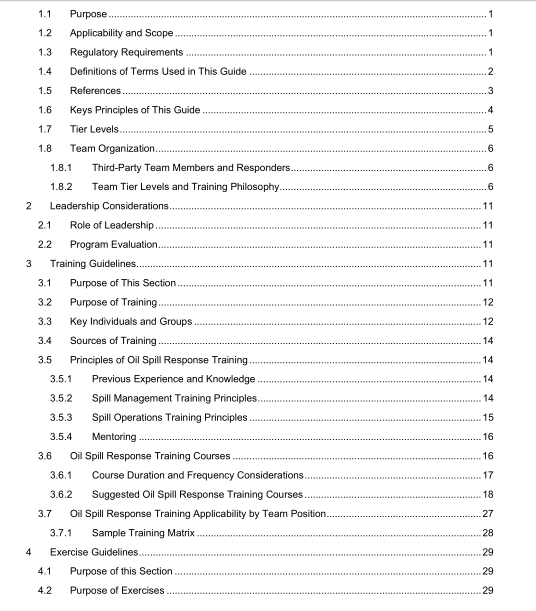API TR 1159 pdf download

API TR 1159 pdf download Guidelines for Oil Spill Response Training and Exercise Programs Guidance for Spill Management Teams and Oil Spill Responders
1.8Team Organization
organizations may use the team position titles and organizational structure of the Incident CommandSystem (IcS),closely aligned with the u.s. Coast Guard’s Incident Management Handbook. lt isunderstood that organizations may modify their team structure to meet their specific needs, but stilattempt to maintain consistency with lcS.ICS is scalable and modular, and can be used to organize eachteam tier level.
lt is understood that Spill Management Team positions may be filled by any combination of employees,contractors or consultants. The training guidelines in this document are position-specific, and thus wouldapply to any individual filling that role, regardless of their relationship to the organization.
1.8.1 Third-Party Team Members and Responders
Organizations may integrate (by contract or other means) professional oil spill removal organizations, co-operatives, private companies,consultants,individuals,and non-governmental organizations into theirtactical oil spill operations and Spill Management Team.
Personnel who are oil spill responders or managers as a profession would be expected to receive trainingand hands-on experience necessary to fll such roles by their employer,and not necessarily follow thetraining and exercise program described in this document.
Organizations should establish or adopt a due diligence program to verify third-party personnel haveadequate training and experience for the roles they will ill on the Spill Management Team or to conducttactical oil spill operations.
1.8.2Team Tier Levels and Training Philosophy
The following diagrams illustrate how Spill Management Teams may be organized for each Tier level,which can be used to provide the foundation for describing the organization’s training program. The actualdesign of the organization’s team levels will vary, depending on its unique requirements.
Training levels for some team positions at the Unit,Group, or Division level may not be dependent on thespill Tier, since they perform the same tasks regardless of the size and complexity of the spill. Otherpositions at the Command and General Staff level and Branch level require advanced training, since thecomplexity of managing higher tier spills requires more knowledge and skill.
The organization should determine the organization and staffing of their Spill Management Team(s), thenassign training requirements for each position based on their oil spill risk profile.
In accordance with NIMS ICS principles, the Incident Commander retains the roles and responsibilities of team positions not activated. For a Tier 1 oil spill that can be resolved with immediately available personnel and equipment, the Spill Management Team may only require a few positions. Agency personnel may briefly visit the scene for oversight, but a Unified Command may not be formally established. The Planning Section Chief, if activated, would perform all the roles of the Planning Section (Situation, Documentation, Resources, etc.) unless those Units were activated. Training requirements for a Tier 1 team would focus on safety, basic response management skills, site- specific cleanup strategies, and tactical operations for known types of oil spills in a known operating environment. A Tier 1 team would not normally need advanced training in sustained response management techniques or a high degree of knowledge in all oil spill response strategies and tactics. Cleanup operations would typically only involve basic containment and mechanical recovery.
A Tier 2 oil spill response would typically require activation of all Spill Management Team Sections, along with all necessary branches, groups and units. Source control functions may be required. Additional Command Staff positions might be activated to address specific external or ancillary issues. The Unified Command would typically be formally established. This organization, fully staffed with alternates, would be capable of sustaining a response for an extended period of time. Training for the Tier 2 team and spill responders would include advanced safety concepts and practices, the ability to sustain the response through multiple Planning Cycles and development of written Incident Action Plans, advanced skills in team organization, handling incident logistics, methods of incident procurement and cost-tracking, source control methods and strategies, knowledge and skills in all appropriate oil spill strategies and tactical operations, and application of technical specialties.









